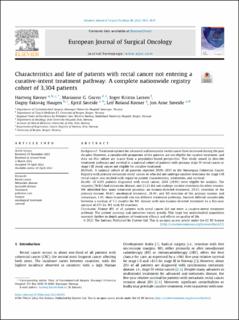| dc.contributor.author | Kørner, Hartwig | |
| dc.contributor.author | Guren, Marianne | |
| dc.contributor.author | Larsen, Inger Kristin | |
| dc.contributor.author | Haugen, Dagny Renata Faksvåg | |
| dc.contributor.author | Søreide, Kjetil | |
| dc.contributor.author | Kørner, Leif Roland | |
| dc.contributor.author | Søreide, Jon Arne | |
| dc.date.accessioned | 2022-09-14T09:11:12Z | |
| dc.date.available | 2022-09-14T09:11:12Z | |
| dc.date.created | 2022-08-30T14:07:58Z | |
| dc.date.issued | 2022 | |
| dc.identifier.issn | 0748-7983 | |
| dc.identifier.uri | https://hdl.handle.net/11250/3017748 | |
| dc.description.abstract | Background: Treatment options for advanced and metastatic rectal cancer have increased during the past decades. However, a considerable proportion of the patients are not eligible for curative treatment, and data on this subset are scarce from a population-based perspective. This study aimed to describe treatment pathways and survival in a national cohort of patients with primary stage IV rectal cancer or stage I-III rectal cancer not eligible for curative treatment.
Methods: A national cohort of all patients reported 2008–2015 to the Norwegian Colorectal Cancer Registry with primary metastatic rectal cancer or who did not undergo curative resections for stage I-III rectal cancer was studied with regard to patient characteristics, treatments, and survival.
Results: Of 8291 patients diagnosed with rectal cancer, 3304 (39.9%) were eligible for analysis. The majority (76.8%) had metastatic disease, and 23.2% did not undergo curative resections for other reasons. We identified four main treatment journeys: no tumour-directed treatment, 25.1%; resection of the primary tumour, 44.6%; oncological treatment, 28.4%; and R0 resection of the primary tumour and metastases, 1.9%; these translated into ten different treatment pathways. Survival differed considerably between a median of 5.3 months for M1 disease with non-tumour-directed treatment to a five-year survival of 67% for M1 with R0 resection.
Conclusion: Almost 40% of all patients with rectal cancer did not enter a curative-intent treatment pathway. The patient journeys and outcomes varied greatly. This large but understudied population warrants further in-depth analyses of treatment efficacy and effects on quality of life. | en_US |
| dc.language.iso | eng | en_US |
| dc.publisher | Elsevier | en_US |
| dc.rights | Navngivelse 4.0 Internasjonal | * |
| dc.rights.uri | http://creativecommons.org/licenses/by/4.0/deed.no | * |
| dc.title | Characteristics and fate of patients with rectal cancer not entering a curative-intent treatment pathway: A complete nationwide registry cohort of 3,304 patients | en_US |
| dc.type | Journal article | en_US |
| dc.type | Peer reviewed | en_US |
| dc.description.version | publishedVersion | en_US |
| dc.rights.holder | Copyright 2022 the authors | en_US |
| cristin.ispublished | true | |
| cristin.fulltext | original | |
| cristin.qualitycode | 1 | |
| dc.identifier.doi | 10.1016/j.ejso.2022.04.013 | |
| dc.identifier.cristin | 2047238 | |
| dc.source.journal | European Journal of Surgical Oncology | en_US |
| dc.source.pagenumber | 1831-1839 | en_US |
| dc.identifier.citation | European Journal of Surgical Oncology. 2022, 48 (8), 1831-1839. | en_US |
| dc.source.volume | 48 | en_US |
| dc.source.issue | 8 | en_US |

